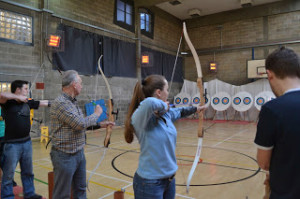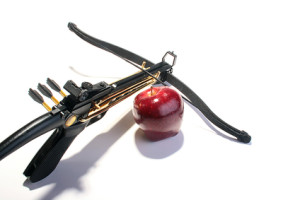Ask the Experts : What’s the Difference Between a ‘Recurve’ Bow and a ‘Traditional’ Bow?
So, we’ve decided to move our occasional “Ask the Expert” series away from facebook and onto our blog. Mainly because our experts (our instructors) are chronically unable to write a short answer when asked anything about archery. Be warned if you’re at the club and you start a query with, “Quick question…” it might be a quick question but it’s usually a lengthy answer!
So, this “Ask the Experts” is from Roger (well done Roger!) and gives an account of the differences between Recurve Bows (as used in the modern Olympics), Longbows (think Agincourt, Robin Hood etc), Horsebows (the short ones with leather webbing around them that you sometimes see in the club) and finally a little bit on crossbows. Please do add any other “Ask the Experts” questions in the comments below – we love talking bows and arrows!
Over to Roger :
“The difference between a modern recurve bow, a long bow and a horse bow is fundamentally one of curves and materials.
When unstrung an English (or Welsh or Scottish) long bow was – and is – a straight stave (wooden pole) with a D shaped cross section where the flat part faces away from the archer. They are typically 3” longer than the archer is tall. When strung, the bow takes a regular uniform curve towards the archer. They were traditionally made either from using several layers of different woods laminated together, or from a single stave of wood (self-bows). Laminated bows are made using woods that favour compression on the belly of the bow (the side that faces the archer), and woods that stretch well on the back of the bow (the side that faces the target). Self-bows tend to be slower and weaker although self bows made of yew or osage orange can be stronger as it is possible to find differing qualities of compression and tensional strength in a single stave, providing the same benefits as a laminated bow. The advantage of the long bow design is that it can be made very strong and can be tensioned to very high draw weights. In some cases these bows can reach over 180lb in draw weight (usually known as war-bows) – this allowed bowyers to manufacture bows that were capable of shooting an arrow through medieval plate armour at ranges as far as fifty yards or more.
The modern recurve bow is so called because the limb-tips of the bow ‘re-curve’ back away  from the archer after the usual longbow curve. They usually have a static (unbending) riser and curved limbs. They also have a window cut into the bow to allow the arrow to take a straighter path through the bow. The window helps with accuracy as it allows the use of a stiffer arrow that can fly straighter than those released from a traditional bow where the arrow must bend itself back around the bow as its released in order to reach the target. The rationale behind the limbs “re-curving” away from the archer at the tips is so that the very ends of the limbs can be accelerated faster than the rest of the limb – this results in energy being transferred more efficiently. Ultimately this results in faster arrow speeds and improved accuracy on the target. Modern recurve bows are now typically fitted with various accessories such as artificial sights, stabilisers and vibration dampers to provide a more consistent shot.
from the archer after the usual longbow curve. They usually have a static (unbending) riser and curved limbs. They also have a window cut into the bow to allow the arrow to take a straighter path through the bow. The window helps with accuracy as it allows the use of a stiffer arrow that can fly straighter than those released from a traditional bow where the arrow must bend itself back around the bow as its released in order to reach the target. The rationale behind the limbs “re-curving” away from the archer at the tips is so that the very ends of the limbs can be accelerated faster than the rest of the limb – this results in energy being transferred more efficiently. Ultimately this results in faster arrow speeds and improved accuracy on the target. Modern recurve bows are now typically fitted with various accessories such as artificial sights, stabilisers and vibration dampers to provide a more consistent shot.
The horse bow or reflex bow is the original recurve bow. They were common in Eastern European countries, the Middle East and throughout Asia and parts of Africa in pre-gunpowder days. They are characterised by their short length and exceptionally recurved limbs. When unstrung a traditional horse bow will curve away from the archer forming a complete C shape, but in some instances are so flexible that the limb tips almost touch forming an O shape. Their short profile made them highly successful as hunting bows (as they’re more manouverable than longer bows). They were originally made of wood laminated with horn and animal sinew although today they may be made with synthetic materials which make the bow cheaper to make and easier to use.
Finally, while we’re thinking about traditional bows, a crossbow can be loosely described as a  short bow that is allowed to lie horizontally on a stock from which position it can have an arrow loaded and released using a trigger mechanism in a similar configuration to a rifle. The main advantage of a crossbow as a weapon is that once the string is drawn back it can be locked into place until the trigger is pulled. This allows the weapon to be loaded without being pointed at the target and without requiring any extra energy to be held at full draw for extended periods of time. Crossbows typically have much higher draw weights as the hold is done mechanically. Drawing or ‘cocking’ the bow can also be achieved with mechanical assistance by using a cocking aid. This means that bows over 100lb may be loaded with the aid of a winch by a single person. Cross bow limb design covers most types of bow shape and materials ranging from un-recurved basic wood through reflexed horn and sinew, to space-age material and radical modern design.”
short bow that is allowed to lie horizontally on a stock from which position it can have an arrow loaded and released using a trigger mechanism in a similar configuration to a rifle. The main advantage of a crossbow as a weapon is that once the string is drawn back it can be locked into place until the trigger is pulled. This allows the weapon to be loaded without being pointed at the target and without requiring any extra energy to be held at full draw for extended periods of time. Crossbows typically have much higher draw weights as the hold is done mechanically. Drawing or ‘cocking’ the bow can also be achieved with mechanical assistance by using a cocking aid. This means that bows over 100lb may be loaded with the aid of a winch by a single person. Cross bow limb design covers most types of bow shape and materials ranging from un-recurved basic wood through reflexed horn and sinew, to space-age material and radical modern design.”
As well as Target Archery there are many other disciplines that use both / all types of bows. You can get involved in everything from clout shooting, Archery Tag, field archery, bowfishing and the curiously named ‘Popinjay’ shoots… but what they all are will be for another post…!
As always, comments and questions are welcomed and suggestions for other “Ask the Experts” are especially useful!


I’ve been at 2020 for about 9 months now. I’ve heard and seen a fair few members adding or taking twists off their strings. What effect does this have and why is it beneficial?
Great question Kim. I’ll add it to the list for future Ask the Experts. Sneak preview (I’ll write this up to make more sense later) but basically it’s to keep the brace height stable… if your brace height changes so will your nock point and probably your centre shot (set with your button). Bottom line is different forces going into your arrow. More twists = short string = high brace height. Less twists = longer string = lower brace height. Recommended brace height is slightly different for every riser and archer (you need to do tuning to find your perfect distance to get a good shot and a nice sounding bow) but you’re looking at about 9″ for a 68″ bow. Use a brace height gauge to check.
Pingback: Blog | 2020 Archery
Pingback: How to navigate our blog and a bit of a contents list! | Archery Blog | 2020 Archery
Sir I have been trying to find information about a Black Hawk Lord long bow 11 24 64 , L-360 , 38#@28″ , 69″ I received it from my father in law some yrs back I have found out where it was made and I believe the yr is 1964 when the four new bows were built but I have no idea of its worth, I’m just looking for some advice thank you very much for your help
Pingback: Archery Blog: 5 Tips for Surviving a Zombie Apocalypse | 2020 Archery
I hope that recurve bow 2020 will be small and will be stronger :))
Hi, great information. I am 32 years now. Which recurve bow feets for me?
Hi David, the size of the bow will be related to how tall you are and how long your arms are (to establish draw length). Maybe head to a local archery store to ask for some assistance? Best wishes, 2020 Archery
Hi
“They were originally made of wood laminated with horn and animal sinew although today they may be made with synthetic materials which make the bow cheaper to make and easier to use.”
which materials do you think are the best enhnancers of the bow’s strenghth i.e. the force it gives to the arrows? Carbon fiber?
I’m not 100% sure of the answer euroarcher. We are hoping to get a shop involved with our blog soon & this is exactly the sort of question we’ll be wanting to put to them. Thanks for the inspiration for some future blog posts!
Why is back of bow straight ive made a bow while camping but i didnt put back straight its round and just wondering what effects does it have to put a straight back (D shaped) on a bow
Hi Pablo, I think that you might have to go to a proper bowyer for that question! I think it really depends on what you’re trying to get out of the bow in terms of efficiency and longevity but it’s going to be a complex question of balancing all the different aspects with the wood that you have.
Thank you i just wondering if it really made it not work effectively thank you i could learn by experience
Pingback: Buying Your First Bow Part 1 | 2020 Archery